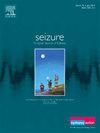Infantile Epileptic Spasms Syndrome: Unveiling clinical and genetic variability in a case series from Argentina
IF 2.7
3区 医学
Q2 CLINICAL NEUROLOGY
引用次数: 0
Abstract
Purpose
Infantile Epileptic Spasms Syndrome (IESS) is the most prevalent epileptic encephalopathy (EE) in the first year of life, with approximately 40 % of cases of genetic or unknown origin. This study aims to describe the clinical and molecular characteristics of a group of Argentine patients diagnosed with IESS of unknown etiology.
Methods
A retrospective analysis was performed on the clinical data of 24 pediatric patients diagnosed with IESS with hypsarrhythmia, who underwent genomic studies between 2019 and 2022.
Results
A genetic etiology was identified in 50 % of cases (eight boys and four girls; median seizure onset age: 3 months). Most of them initiated with IESS and over half evolved into Lennox-Gastaut syndrome. Developmental delay preceded seizure onset in all patients, persisting or worsening thereafter. Notable features included hypotonia, microcephaly, and dysmorphisms. Half of the patients had a family history of epilepsy, and two of EE. Identified variants included 7/13 (53.8 %) single nucleotide variants in KCNQ2, STXBP1, SCN8A, CDKL5, UGDH, and WWOX; 5/13 (38.5 %) copy number variants involving the genes UBE3A-GABRB3-GABRA5, SCN2A-SCN1A-SCN9A, and WWOX; and a short tandem repeat in ARX. Inheritance patterns included autosomal dominant (n = 8), recessive (n = 2), and X-linked (n = 2). Nine variants (69.2 %) were presumed de novo.
Conclusion
These findings underscore the extensive genetic heterogeneity of IESS within the Argentine population, enriching the international literature and variant databases with Latin American data. In cases with an unknown cause, genetic testing is crucial in establishing an etiological diagnosis, guiding appropriate treatment, and facilitating genetic counseling.
婴儿癫痫痉挛综合征:揭示临床和遗传变异的病例系列从阿根廷
目的:婴儿癫痫性痉挛综合征(IESS)是生命第一年最常见的癫痫性脑病(EE),约40%的病例是遗传或不明原因的。本研究旨在描述一组阿根廷诊断为病因不明的IESS患者的临床和分子特征。方法回顾性分析2019年至2022年24例诊断为IESS伴心律失常的儿科患者的临床资料。结果50%的病例(男孩8例,女孩4例;中位癫痫发作年龄:3个月)。其中大多数以IESS开始,超过一半发展为lenox - gastaut综合征。所有患者发病前均有发育迟缓,发病后持续或恶化。显著特征包括张力减退、小头畸形和畸形。半数患者有癫痫家族史,两名患者有EE家族史。鉴定的变异包括KCNQ2、STXBP1、SCN8A、CDKL5、UGDH和WWOX中7/13(53.8%)的单核苷酸变异;5/13(38.5%)拷贝数变异涉及基因UBE3A-GABRB3-GABRA5、SCN2A-SCN1A-SCN9A和WWOX;在ARX中进行短串联重复。遗传模式包括常染色体显性(n = 8)、隐性(n = 2)和x连锁(n = 2)。9个变异(69.2%)被认为是从头开始。结论这些发现强调了阿根廷人群中IESS广泛的遗传异质性,丰富了国际文献和拉丁美洲数据的变异数据库。在病因不明的病例中,基因检测对于确定病因诊断、指导适当治疗和促进遗传咨询至关重要。
本文章由计算机程序翻译,如有差异,请以英文原文为准。
求助全文
约1分钟内获得全文
求助全文
来源期刊

Seizure-European Journal of Epilepsy
医学-临床神经学
CiteScore
5.60
自引率
6.70%
发文量
231
审稿时长
34 days
期刊介绍:
Seizure - European Journal of Epilepsy is an international journal owned by Epilepsy Action (the largest member led epilepsy organisation in the UK). It provides a forum for papers on all topics related to epilepsy and seizure disorders.
 求助内容:
求助内容: 应助结果提醒方式:
应助结果提醒方式:


